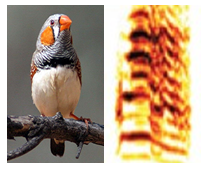Architecture, dynamics, and resilience of brain circuits
Our laboratory investigates the mechanisms by which the coordinated activity of neurons connected to each other in circuits gives rise to brain function. To address this issue we focus on three complementary questions: (i) what is the wiring diagram of the connections that link neurons together in a circuit?, (ii) how does information flow through a neuronal circuit?, and (iii) what are the mechanisms by which the function of brain circuits remains reliable despite noise?. To investigate these questions we are developing new genetic technologies to identify neuronal connectivity, to manipulate the biophysical properties of neurons, and to record their dynamics. In addition, we use electrophysiological methods to study neuronal activity in single cells, and optical imaging methods to record the activity of large numbers of neurons in behaving animals.

Wiring diagrams of brain circuits
Understanding how information flows through brain circuits requires identifying how neurons in those circuits are connected to each other. We have designed a new genetic strategy to visualize the wiring diagram of brain circuits based on transneuronal activation of transcription. This system is allowing us not only to identify the connections between neurons, but also to genetically modify the physiological properties of circuits of connected neurons. We anticipate that this research will provide fundamental insights to understand how neuronal activity in brain circuits gives rise to behavior. We initially developed this tracing method in Drosophila because of its powerful genetics, and are currently applying it to visualize wiring diagrams in the mouse brain.

Generation of sequences by brain circuits
One of the fundamental characteristics of brain function is that neuronal activity occurs in a sequential manner. For example, all motor behaviors are characterized by the activation of muscles in a defined sequence. How does information flow through a neuronal circuit to generate sequences? Birdsong is an ideal system where to study the generation of sequences by brain circuits, because a song is a sequence of sounds that birds use to communicate. In addition, birds have specialized brain circuits dedicated to the production and perception of song. We are investigating the wiring diagram of these brain circuits, and how activity flows through these circuits to generate songs. To study these questions our laboratory has developed new methods that allow us to genetically modify the biophysical properties of songbird neurons, and to record the activity of large numbers of neurons in freely moving, behaving animals.

Resilience of neuronal activity in brain circuits
Brain function is remarkably reliable despite the imprecise performance of neurons, and the continuous perturbations caused by aging, disease or injury. How does the brain succeed in producing stereotypic behaviors over long periods of time despite these perturbations? We are interested in studying the cellular mechanisms by which neuronal circuits are able to "self-tune" and adapt to perturbations. We are using genetic manipulations to perturb brain circuits to ask two types of questions: (i) how do brain circuits adapt when a large percentage of their neurons are deleted or silenced?, (ii) how do brain circuits adapt when electrical noise is injected into the system?. To study these questions we are focusing on two different brain circuits: (a) the mouse olfactory system, where we can genetically perturb selective neuronal types with high precision, and (b) the song circuits of birds, because song is an extremely stereotypical behavior that can be rigorously measured
Please click here for more information on Carlos Lois and his research.

